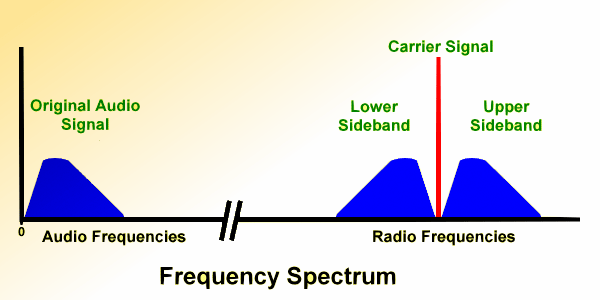
| How is a Radio Frequency Signal Modulated to Carry Information? |

After having understood why it is necessary to modulate radio frequency, let us now figure out the practical ways by which radio signal modulation might be done. If we were to take a look at the typical electrical waveform of a baseband information signal like the human voice, we find that it is essentially a continuous variation of the voltage output from a microphone. The nature of the voltage variation is such that it follows the voice variation in terms of amplitude. In other words, it is the variation in the envelope of the voltage waveform that closely follows our voice pattern. Therefore, a way must be found to faithfully transfer this envelope variation pattern to the radio frequency at the transmitter (called modulation), while at the receiver end, to extract the same envelope variation information from the radio wave (called demodulation) to reconstruct a replica of the original baseband signal voltage. 
For the modulation and demodulation process to occur, we first need to identify an attribute of the radio frequency carrier that could be continually varied in consonance with the baseband signal characteristics. Luckily, there is not only one but at least three distinct attributes of any sinusoidal RF carrier that might be used to achieve our objective. These attributes are the amplitude, frequency, or phase of the radio frequency carrier. We may choose any one of them. When we choose to modulate (vary) the amplitude of the RF carrier in accordance with the variation in voltage envelope of the baseband signal, then the process is termed as Amplitude Modulation (AM). Similarly, if we choose to vary the frequency it is called Frequency Modulation (FM), or else, if we choose to vary the phase of the RF carrier then it is Phase Modulation (PM). Each of these three basic forms of modulation has its own strengths and weaknesses. We will discuss this in a moment… One might wonder at this point, how about SSB? Why are you quiet about it? Well, SSB is simply a variant of AM and its modulation attribute is the same as that of AM. We will focus on it in fair depth as we progress through this article. At this point, we must understand that the RF carrier in itself does not carry any information unless it is modulated in one of the above ways. The RF carrier may be considered to like a cart that is used to ferry the information payload (baseband signal) from one location to another across great distances through the radio propagation medium. The accompanying illustration shows how modulating an RF carrier changes the way its waveform looks. In the case of AM, one can clearly see that the amplitude of the RF carrier varies in accordance with the baseband signal envelope, while in the case of FM, the frequency of the carrier varies accordingly, and so on. The illustration should be self-explanatory. |
| Leave Message |
Message Has Been Sent Successfully
|